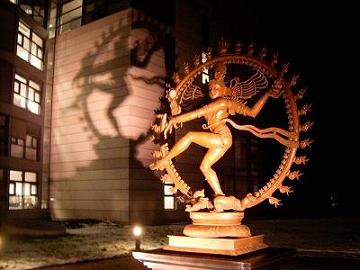During the Chola period (10th to 11th centuries CE), Tamil Nadu became the centre for crafting magnificent bronze sculptures of deities. Dr. R. Nagaswamy, former director of archaeology in Tamil Nadu, has researched this art and helped to unearth several masterpieces. He supervised excavations in temple towns to discover priceless bronzes and fought in international courts to return smuggled ones back to the temples. He has unique anecdotes about the idols made in various metals - gold, silver, copper, brass and most common, bronze. He was consultant to the Indira Gandhi National Centre for the Arts, New Delhi, for rediscovering the magic of the Brihadishwara temple in Tanjore, Tamil Nadu.
Temples are the abodes of gods,” says Dr. Nagaswamy, “They require two kinds of images. Those which are fixed permanently in the sanctum and the sub-shrines are called Achala Bimba or immovable reflections of divinity. Each temple also requires transportable idols for worship or festive processions. These are called Chala Bimbas, or moveable reflections of divinity. The latter are used in festive rituals and processions. These events are described in detail in the ancient Agamas, which are records of temple architecture and the exact manner of consecrating deities and worshipping them. The Agamas are books which describe every possible detail of handling icons and conserving them. These books are also the fonts of Vastu Shastra, the science which has gained immense popularity today.
“Bronze and other metal icons of Tamil Nadu mostly belong to the Chola and Pallava eras of history between the 6th and 11th century A.D. The Pallava dynasty built temples across the verdant landscape of Tamil Nadu, but these were small and their spires rose to heights of 20 to 60 ft. Thus, their bronzes of Shiva, Vishnu, Parvati, Lakshmi, Kartikeya and Ganesha were also small in consonance with the rules of the Agamas. The Cholas, who were true empire builders, built huge temple complexes and their icons were also proportionately larger and more perfectly designed. Bronzes and other metal icons of the Chola era were either cast hollow or were solid.
“The greatest temple builder of the Chola dynasty was Rajaraja, the powerful warrior king. He built the Brihadeeshwara temple in Tanjore which is 200 ft tall. Rajaraja called this temple the Dakshinameru or the golden mountain of the south and covered the entire spire of the temple in gold (to see pictures link below). For centuries, bronze iconography flourished in and around this temple. According to the records and inscriptions in the temple, that a total of 85 idols of Shiva as Nataraja, Tripurantaka and Kalyansundara as well as some icons of Vishnu were housed in this temple. However, there are only a few available today. Sembian Mahadevi, a senior Chola queen who ruled this territory, was also a great promoter of the iconography of Shiva and Vishnu and many exquisite bronzes were made during her rule. The facial expressions, the ornamentation, the grace of posture, the proportions of limbs and the spiritual significance of these bronzes are incomparable.
“Many other great temples came to be built in the Chola period. Rajendra, the great conqueror from this dynasty, expanded his empire to Bengal and built the Gangaikonda Cholapuram temple, based on the laws of the Agamas, to celebrate his victory over the Gangetic Plain. His queen Lokadevi also built her own temple 11 km away. It is recorded that the workers, managers and administrators in this temple were all women. Women, judging from the records the queen has left behind, were given high positions and equal status in the Chola era.
“The art of making bronzes reached its zenith during the Chola era between the 10th and 11th centuries. These are unique art creations which have attracted connoisseurs from all over the world. Many have been sold by art thieves, many have been smuggled out of the temples or even the country and many have landed in museums or private collections. I have also seen that many icons lie buried according the rites in the Agamas in times of war with the invading Islamic armies who came from the north. The icons were hidden in secret vaults under sand brought from rivers for conservation. I was myself fortunate to go underground in one such temple to find a treasure of idols which have now been housed in temples or museums. Since it was customary to bury them during floods, famines, enemy attacks and scourges, it is possible that even today, there are treasures of bronzes lying underground, waiting to be discovered by us and given the glorious place they deserve in our lives.”
The Cholas – perhaps Peninsular India’s most powerful dynasty – came to power in the late 9th century A.D. and until the late 13th century, ruled most parts of peninsular India and even parts of Indonesia’s Java island. Their capital was Thanjavur (Tanjore), a city founded by Vijalaya who captured the city in 850 A D. His son, Rajendra I (1012 to 1044 A D) and their maritime ventures created ties with Burma, China and Malaysia across the sea. However, successive Chola rulers are known more for what they built rather than their conquests. During their rule poetry, theatre, music and dance flourished as arts. The magnificent temples commissioned by them were marvels of architecture with perfectly carved sculptures and icons of deities as well as human beings. With their rule, bronze-casting became a huge art in South India – the masterpiece of all time being the icon of the Nataraja or dancing Shiva in golden-spired Chidambaram temple.
See pictures of –
•Brihadesvara Temple
•Chidambaram Temple

Shiva Nataraja in Geneva |

Bronzes, Shiva and Uma 14th century |